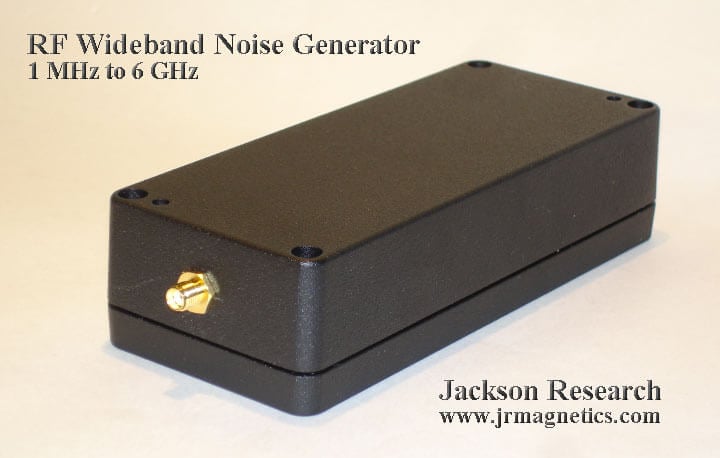Kickstarter for a Lower Cost Laboratory Grade RF Broadband Noise Generator
UPDATE: John wanted to add the following clarification:
In the article you wrote, you suggest that the two noise generators are equivalent. This is not the case. The noise generator you mentioned generates "Thermal Noise". Mine generates "Shot Noise".
The Zener in the generator you mentioned, contributes zero noise in the Gigahertz spectrum. Whereas mine generates Shot Noise roughly 20 db higher than the thermal noise floor all across the range.
The physics and the mathematics are as different as night and day.
Thank you to John Jackson from Jackson Research for writing in and sharing his Kickstarter for a laboratory grade RF broadband noise generator. John notes that he's discovered a semiconductor that is much cheaper than the expensive avalanche diodes used in other high end noise sources. This semiconductor has allowed him to create a noise source that works from 40 MHz up to 6 GHz. The target output power is 0 dB, with a flatness of less than 2 dBm over the entire bandwidth.
A noise source is useful for SDR/radio experiments as it is used in many applications such as scalar network analyzers, filter response measurements, satellite tuning, cellphone network tuning, antenna VSWR measurements, amplifier noise measurements and in jammers. If you're interested we have a previously posted tutorial about using an RTL-SDR and noise source for filter characterization and antenna VSWR measurements.
John is fundraising via Kickstarter in order to help fund development of the final product. The pricing is currently US$500. This might seem high, but John notes that comparable professional noise sources start at US$3,500 and go up to US$30,000. John writes:
There are a number of laboratory grade RF Noise generators on the market. They are all extremely expensive ranging in the thousands of dollars. This is beyond the reach of most individuals. In contrast, there are some low cost RF noise generator schematics floating around the Internet which are all based upon Zener diodes.
The problem with Zener diodes is the noise bandwidth. All the circuits I have seen have cutoff frequencies in the Megahertz range. The one noise circuit I saw used in the Gigahertz range was actually amplifier noise and had problems due to the several stages of amplification.
The alternative to Zener diodes is the avalanche diode specifically designed as a RF noise generator. These devices are difficult to acquire and have very high prices which often exceed the entire cost of all the parts and components needed to build the instrument.
Professor Jackson at Jackson Research has discovered a semiconductor that generates RF noise like an avalanche noise diode into the Gigahertz range, but at Zener diode prices. He has raw laboratory data and now needs to build up a professional grade instrument. To achieve this goal, he has launched a new KickStarter fund raiser to build up a number of units.

we can use the KerberosSDR as a Noise Source.
I’ve added a clarification that John wanted to add to the post. I’ve also asked him to provide more info on his Kickstarter page on the difference between shot and thermal noise, and why it matters in a noise source.
I suspect RF hobbyists will find that too pricey. In a proper metal enclosure it might appeal to the pros.
If you want something reasonably priced that is better than the Chinese noise sources and calibrated, this is a good supplier.
https://g8fek.com/index.html
Generic calibrated sources are around £70 GBP individually calibrated are around £150 GBP.
(I also have no connection to this product/company, but I like their products and I’m just sharing the info).
My next door neighbor’s television is a wideband noise source.so i get one for free.
lolz
BG7TBL from China sells Noise Source with Zener Diodes 1MHz-3,5GHz on Ebay for 20 US $. They do the most jobs.
Absolutely!!
radioastronomysupplies has a calibrated noise source for US$135, 20 MHz to 2 GHz. It is not 0 dBm (a spec which actually doesn’t make any sense without a bandwidth; noise power is specified by its temperature), but it is much less than $30000.
(I have no connection to this product/company, just sharing info).